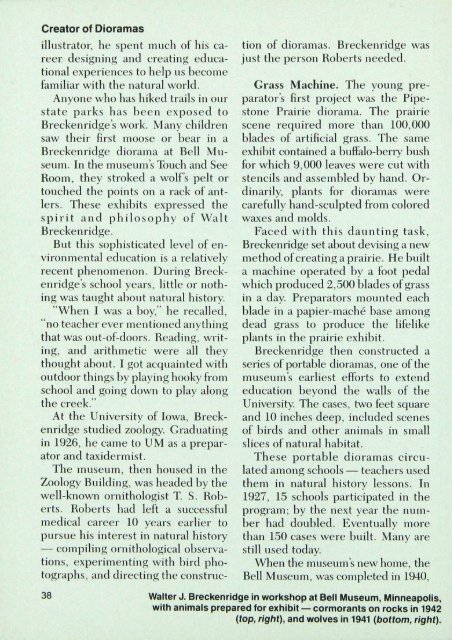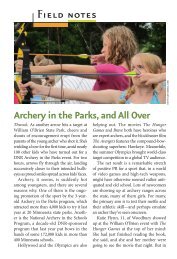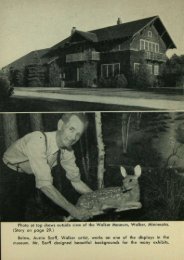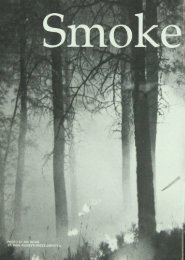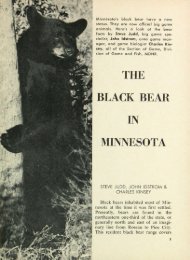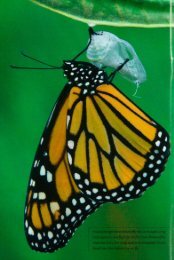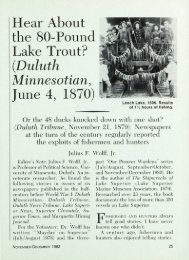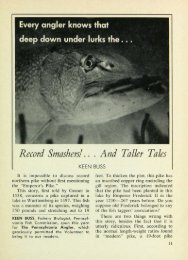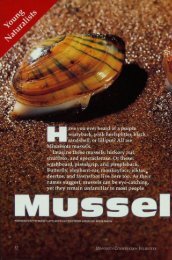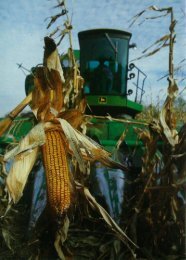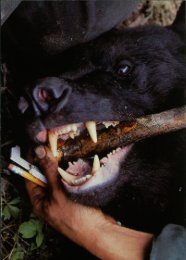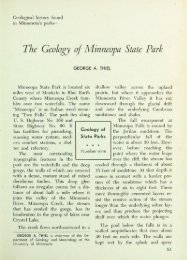218 Bell Museums Creator of Wildlife Dioramas - webapps8
218 Bell Museums Creator of Wildlife Dioramas - webapps8
218 Bell Museums Creator of Wildlife Dioramas - webapps8
Create successful ePaper yourself
Turn your PDF publications into a flip-book with our unique Google optimized e-Paper software.
<strong>Creator</strong> <strong>of</strong> <strong>Dioramas</strong><br />
illustrator, he spent much <strong>of</strong> his career<br />
designing and creating educational<br />
experiences to help us become<br />
familiar with the natural world.<br />
Anyone who has hiked trails in our<br />
state parks lias been exposed to<br />
Breckenridges work. Many children<br />
saw their first moose or bear in a<br />
Breckenridge diorama at <strong>Bell</strong> Museum.<br />
In the museum s Touch and See<br />
Room, they stroked a wolfs pelt or<br />
touched the points on a rack <strong>of</strong> antlers.<br />
These exhibits expressed the<br />
spirit and philosophy <strong>of</strong> Walt<br />
Breckenridge.<br />
But this sophisticated level <strong>of</strong> environmental<br />
education is a relatively<br />
recent phenomenon. During Breckenridges<br />
school years, little or nothing<br />
was taught about natural history.<br />
"When I was a boy," he recalled,<br />
"no teacher ever mentioned anything<br />
that was out-<strong>of</strong>-doors. Reading, writing,<br />
and arithmetic were all they<br />
thought about. I got acquainted with<br />
outdoor things by playing hooky from<br />
school and going down to play along<br />
the creek."<br />
At the University <strong>of</strong> Iowa, Breckenridge<br />
studied zoology. Graduating<br />
in 1926, he came to UM as a preparator<br />
and taxidermist.<br />
The museum, then housed in the<br />
Zoology Building, was headed by the<br />
well-known ornithologist T. S. Roberts.<br />
Roberts had left a successful<br />
medical career 10 years earlier to<br />
pursue his interest in natural history<br />
— compiling ornithological observations,<br />
experimenting with bird photographs,<br />
and directing the construc-<br />
38<br />
tion <strong>of</strong> dioramas. Breckenridge was<br />
just the person Roberts needed.<br />
Grass Machine. The young preparator's<br />
first project was the Pipestone<br />
Prairie diorama. The prairie<br />
scene required more than 100,000<br />
blades <strong>of</strong> artificial grass. The same<br />
exhibit contained a buffalo-berry bush<br />
for which 9,000 leaves were cut with<br />
stencils and assembled by hand. Ordinarily,<br />
plants for dioramas were<br />
carefully hand-sculpted from colored<br />
waxes and molds.<br />
Faced with this daunting task,<br />
Breckenridge set about devising a new<br />
method <strong>of</strong> creating a prairie. He built<br />
a machine operated by a foot pedal<br />
which produced 2,500 blades <strong>of</strong> grass<br />
in a day. Preparators mounted each<br />
blade in a papier-mache base among<br />
dead grass to produce the lifelike<br />
plants in the prairie exhibit.<br />
Breckenridge then constructed a<br />
series <strong>of</strong> portable dioramas, one <strong>of</strong> the<br />
museum's earliest efforts to extend<br />
education beyond the walls <strong>of</strong> the<br />
University. The cases, two feet square<br />
and 10 inches deep, included scenes<br />
<strong>of</strong> birds and other animals in small<br />
slices <strong>of</strong> natural habitat.<br />
These portable dioramas circulated<br />
among schools — teachers used<br />
them in natural history lessons. In<br />
1927, 15 schools participated in the<br />
program; by the next year the number<br />
had doubled. Eventually more<br />
than 150 cases were built. Many are<br />
still used today.<br />
When the museum's new home, the<br />
<strong>Bell</strong> Museum, was completed in 1940,<br />
Walter J. Breckenridge in workshop at <strong>Bell</strong> Museum, Minneapolis,<br />
with animals prepared for exhibit — cormorants on rocks in 1942<br />
(top, right), and wolves in 1941 (bottom, right).


